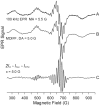Moving difference (MDIFF) non-adiabatic rapid sweep (NARS) EPR of copper(II)
- PMID: 24036469
- PMCID: PMC3919454
- DOI: 10.1016/j.jmr.2013.08.004
Moving difference (MDIFF) non-adiabatic rapid sweep (NARS) EPR of copper(II)
Abstract
Non-adiabatic rapid sweep (NARS) EPR spectroscopy has been introduced for application to nitroxide-labeled biological samples (Kittell et al., 2011). Displays are pure absorption, and are built up by acquiring data in spectral segments that are concatenated. In this paper we extend the method to frozen solutions of copper-imidazole, a square planar copper complex with four in-plane nitrogen ligands. Pure absorption spectra are created from concatenation of 170 5-gauss segments spanning 850 G at 1.9 GHz. These spectra, however, are not directly useful since nitrogen superhyperfine couplings are barely visible. Application of the moving difference (MDIFF) algorithm to the digitized NARS pure absorption spectrum is used to produce spectra that are analogous to the first harmonic EPR. The signal intensity is about four times higher than when using conventional 100 kHz field modulation, depending on line shape. MDIFF not only filters the spectrum, but also the noise, resulting in further improvement of the SNR for the same signal acquisition time. The MDIFF amplitude can be optimized retrospectively, different spectral regions can be examined at different amplitudes, and an amplitude can be used that is substantially greater than the upper limit of the field modulation amplitude of a conventional EPR spectrometer, which improves the signal-to-noise ratio of broad lines.
Keywords: Biological copper; Direct detection; EPR; ESR; MDIFF; Moving average; NARS; Non-adiabatic rapid sweep.
Copyright © 2013 Elsevier Inc. All rights reserved.
Figures










References
-
- Hyde JS, Pasenkiewicz-Gierula M, Jesmanowicz A, Antholine WE. Pseudo field modulation in EPR spectroscopy. Appl Magn Reson. 1990;1:483–496.
-
- Klein MP, Barton GW. Enhancement of signal-to-noise ratio by continuous averaging: application to magnetic resonance. Rev Sci Instrum. 1963;34:754–759.
-
- Ernst RR. Sensitivity enhancement in magnetic resonance. I. Analysis of the method of time averaging. Rev Sci Instrum. 1965;36:1689–1695.
-
- Ernst RR, Anderson WA. Sensitivity enhancement in magnetic resonance. ii. Investigation of intermediate passage conditions. Rev Sci Instrum. 1965;36:1696.
Publication types
MeSH terms
Substances
Grants and funding
LinkOut - more resources
Full Text Sources
Other Literature Sources
Miscellaneous

